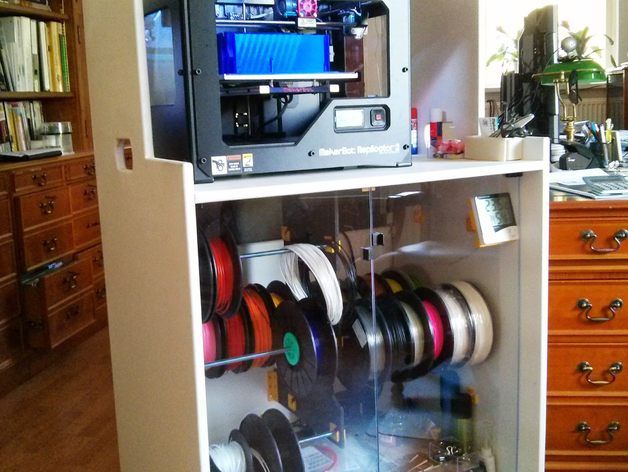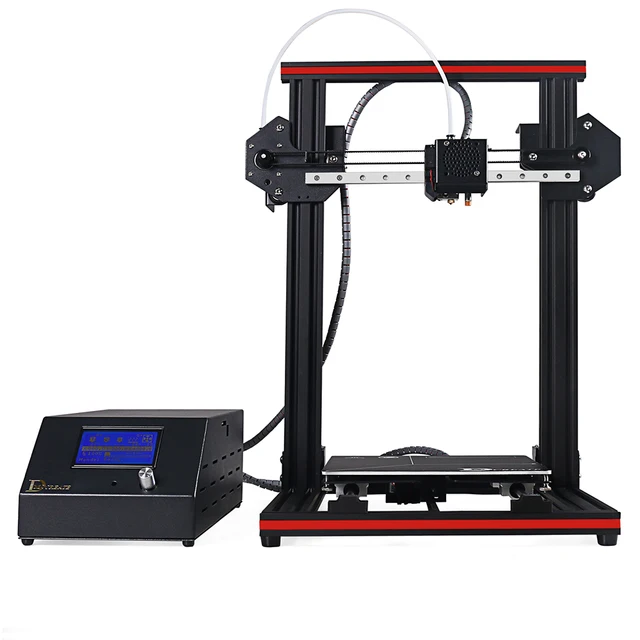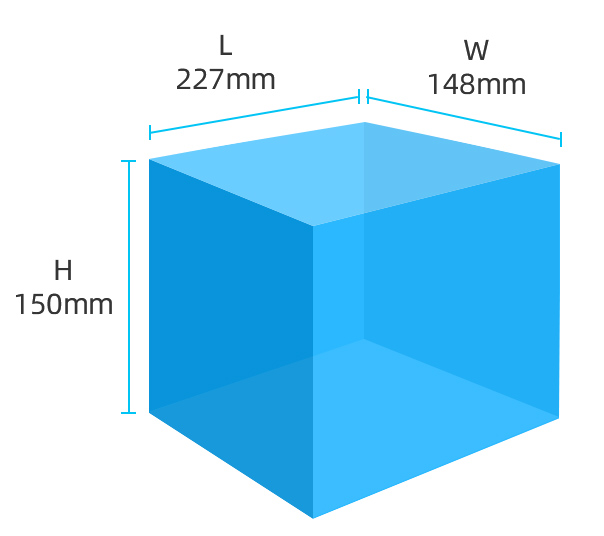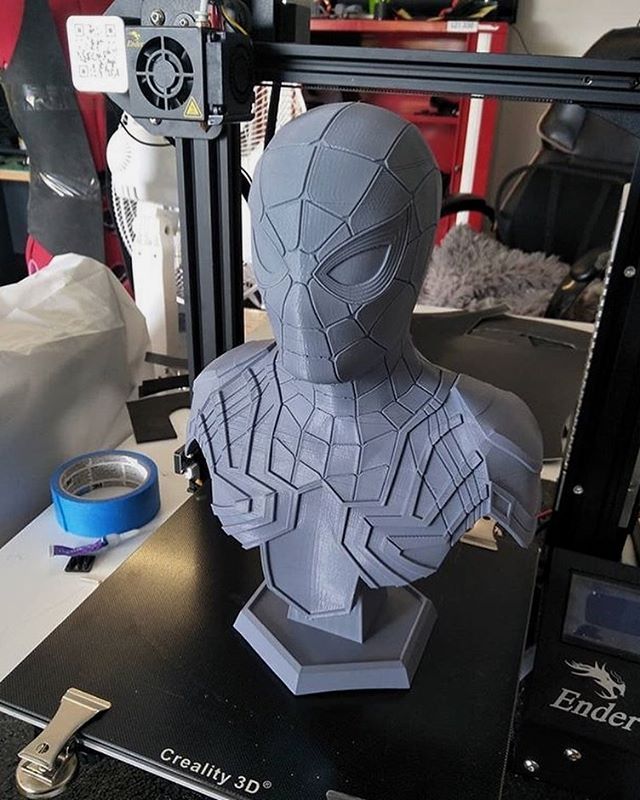3D printing filament dry cabinet
EUREKA DRY TECH ADL-3D77 3D Printing Series Filament Dry Cabinet
3D Printing Filament Storage Dry Cabinet
Moisture absorption in filaments could be a significant cause of failure in 3D printing
Eureka Dry Tech’s ADL-3D77 Filament Dry Box is the perfect humidity controlled solution for filament storage. Our automatic humidity controlled filament dry box will provide a quick and simple way to store filament without hassle. Simply set the desired humidity level, store your filaments and our dehumidifier will take care of the rest. Your filament will stay completely dry, easily accessible, perfectly identifiable (i.e. no need to open every box to find the right kind of filament you are looking for) and filament stays dry and ready to be used anytime you need them for a print.
3D Printing Filament Storage Dry Cabinet features:
- Low humidity environment
- Four filament feed ports allows direct printing from the cabinet while in dry storage.
- Adjustable hanging rod hanging up to 33 cm diameter spools.
- Air tight cabinet prevents moisture and dust.
- Low energy consumption (13 W Avg., 100 W Max).
- No consumable parts, desiccants to replace, no water tanks to empty.
Most may not realize, moisture absorption in filaments could be a significant cause of failure in 3D printing.
Effects of Moisture Absorption by 3D Printing filament material may result in the following problems:- Brittleness and breakage of filament,
- Diameter inconsistency
- Hissing steam or bubbling when filament reaches the hot-end,
- Filament degrading or lose tensile strength,
- Higher extruding temperature
Moisture Sensitivity of Filament Material
Filament polymers are known to absorb moisture and will affect the quality of your print. Whether you use Nylon, PVA, PETT, PLA, PC or ABS or other exotic material filaments, keeping these filaments dry in a humidity controlled "dry filament storage" is one main element to a beautiful & successful print.
Whether you use Nylon, PVA, PETT, PLA, PC or ABS or other exotic material filaments, keeping these filaments dry in a humidity controlled "dry filament storage" is one main element to a beautiful & successful print.
The ADL-3D77 features <10%RH storage environment, suitable for maintaining most filaments in optimal moisture content levels to produce a great print.
Water molecule’s boiling point is approximately 100 °C. Depending on the type of filament material, the extrusion temperature ranges from 160 °C to 250 °C. So any presence of moisture in the filaments will contribute to print failure when the moisture becomes steam and bubbles, causing interference with the flow of plastic out of the hot end while creating unwanted pockets within the finished object.
Storing your 3D printing filaments in a humidity controlled dry box will prevent moisture absorption and eliminate flow interference at the hot end.
Some filament materials (like nylon, and PVA) are more hygroscopic than others, which means it has an inherent quality to attract ambient moisture. If filament spools are exposed to ambient humidity for long periods of time without any storage solution in place, moisture related problems will soon appear during printing. A complicated project could take hours or even days to complete. When a project has been set to run on its own, discovery of problems are often too late. Moisture absorbed in the filament could cause obstructions to the printer’s hot end and may require it to be replaced. Furthermore, moisture absorption can also affect the tensile strength of the filaments and the output objects.
If filament spools are exposed to ambient humidity for long periods of time without any storage solution in place, moisture related problems will soon appear during printing. A complicated project could take hours or even days to complete. When a project has been set to run on its own, discovery of problems are often too late. Moisture absorbed in the filament could cause obstructions to the printer’s hot end and may require it to be replaced. Furthermore, moisture absorption can also affect the tensile strength of the filaments and the output objects.
By consistently storing your 3D printing filaments in Eureka Dry Tech's ADL-3D77 <10%RH environment, you will eliminate any moisture absorption in those hygroscopic filaments during the printing and long term storage process.
When moisture contaminated filament is passed through the hot end, the absorbed moisture in the filament turns into steam and will cause streaks, bubbles, and even brittleness in the print.
Importance of storing filament in moisture controlled storage :
3D Printer Storage Cabinets
Eureka Dry Tech is a fully equipped cabinet manufacturer capable of building custom cabinets to your specification. Cabinet designs elements can include storage of your printer & filament while incorporating dehumidifying, heating & air venting functions.
Contact us today with your specifications and we will provide a custom built storage solution to meet your needs. OEM and group buys are welcome.
For more information regarding Eureka Dry Tech's Filament Dry Cabinet or other products & services we offer, please visit our page.
Photo Source:
https://3dprint.com/49058/filament-moisture-damage/
https://youtu.be/fI4KUJTiNbK
Tags: adl-3d77, 3d printing, filament dryer, filament storage, 3d printing filament, nylon filament, pla filament, extruder, hotend, tensile strength, dry filament, filament drier, filament storage container, filament storage box, filament dry storage, 1.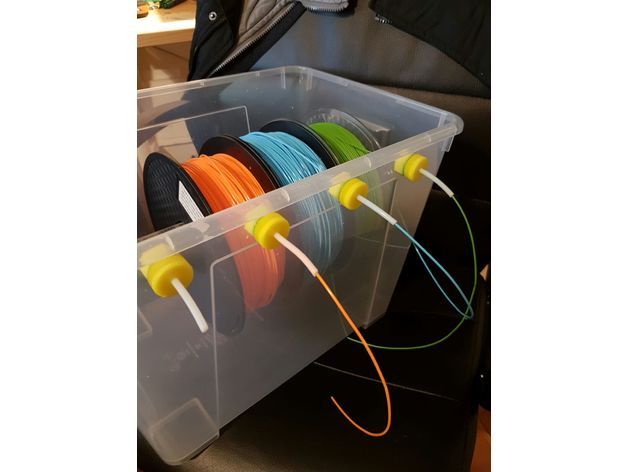 75 mm filament, diy filament dryer, 3d printer filament dehydrator, filament dry box, filament, dry filament in oven, 3d printing filament holder, filament holder, filament dryer
75 mm filament, diy filament dryer, 3d printer filament dehydrator, filament dry box, filament, dry filament in oven, 3d printing filament holder, filament holder, filament dryer
Industrial Filament Dry Cabinet: BigRep SHIELD
REQUEST PRICING
Airtight Chamber
Airtight Chamber
The SHIELD maintains constant overpressure for an airtight storage volume, with 100% air recirculation ensuring environmental moisture won't seep in.
Up to 60 kg Storage
Up to 60 kg Storage
Perfect for industrial users, the massive 276 liters storage capacity provides safe, long-term storage to keep sensitive materials in ideal condition.
Siemens Control System
Siemens Control System
Developed with industry leader Amboss+Langbein, SHIELD maintains moisture thresholds with efficient and intermittent drying cycles using a robust Siemens control system.
10x Better Without Heat
10x Better Without Heat
The SHIELD eliminates 99.9% of airborne moisture without using heat, achieving 10x less humidity than the competition, all without overdrying from long-term heat exposure.
REQUEST PRICING
100X LESS MOISTUREIdeal for sensitive filaments, SHIELD achieves 0.01% humidity, which is 100X better than the competitors.
REDUCE WASTE BY 20%Properly storing your filaments can reduce misprinting up to 20%, minimizing printer downtime and loss in print quality.
50% LESS REPAIR COSTSPrevent workflow disruptions from clogs and printer damage, which can extend the life of your machine up to 50% and reduce repairs by up to 50%.
Filament Dry Box for Ideal Material ConditionsProtect your materials in the BigRep SHIELDDesigned to protect your filament from material degradation, the BigRep SHIELD dry box stores filament in ideal conditions to save you time and money by preventing downtime and damages.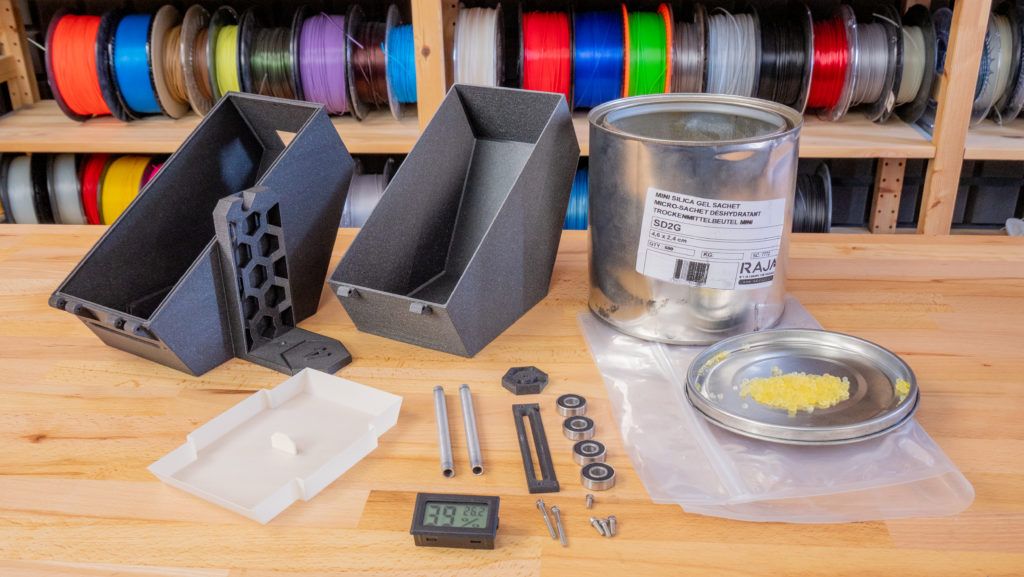
Air circulates in the high-capacity, overpressured chamber - capable of storing up to 60 kg of filament spools - and in the desiccant chamber that achieves 0.01% humidity, crushing the industry standard of 1% by 100X.
Unquestionably vital for the storage of hygroscopic materials, the SHIELD keeps all types of filament in perfect condition, reducing misprints and material waste by up to 20%. Extend the life of your BigRep machine and save up to 50% on repair costs caused by clogging and extruder damage. The SHIELD is a must-have insurance policy to avoid workflow disruptions.
Reliable ProductivityIndustrial Quality and Large Capacity to Secure Your WorkflowNo Humidity, No Heat
The Controlled Desiccant Air Loop
The BigRep SHIELD prevents filament moisture absorption without heat by operating in a sealed environment with highly-effective air circulation.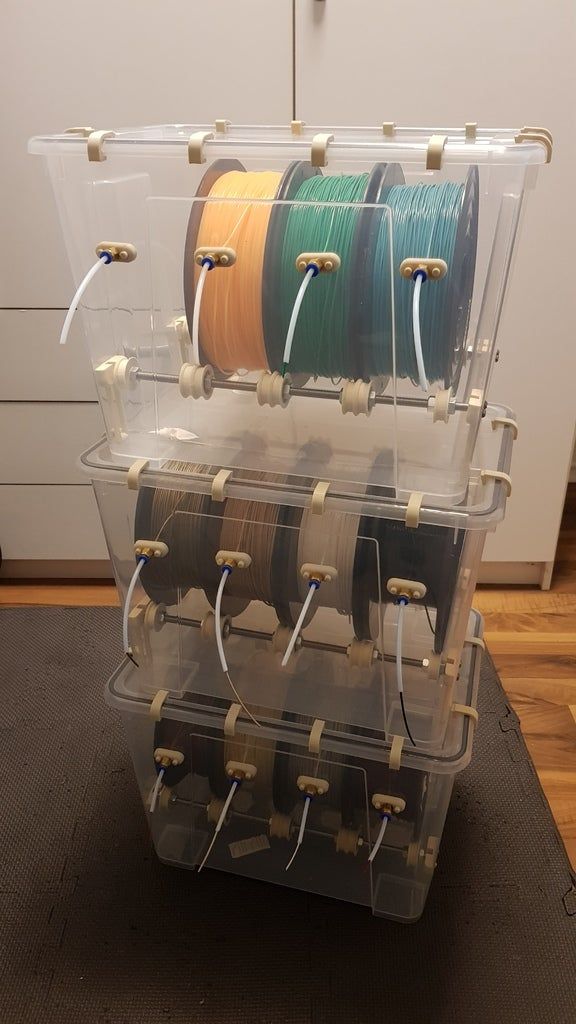 By looping air through a controlled desiccant chamber the SHIELD effectively eliminates 99.99% of airborne moisture, maintaining 0.01% relative humidity to handily beat the 1% industry standard without risking over-drying from long-term heat exposure.
By looping air through a controlled desiccant chamber the SHIELD effectively eliminates 99.99% of airborne moisture, maintaining 0.01% relative humidity to handily beat the 1% industry standard without risking over-drying from long-term heat exposure.
The 60 kg Storage Chamber
The industrial-sized dry box holds up to 60 kg of filament, enough material for one month continuous 24/7 printing. The SHIELD provides ample space for safe, long-term storage of highly-sensitive additive manufacturing materials to maintain their ideal condition.
Constant Over PressureThe Sealed Chamber
The BigRep SHIELD maintains constant overpressure for an airtight storage volume. This prevents new moisture from entering its chamber during regular operation and ensures the system can quickly remove any and all airborne humidity with 100% air recirculation.
Industrial ReliabilityThe Siemens Control System
BigRep collaborated with Amboss+Langbein, an industry leader with almost 40 years expertise in drying systems for plastics manufacturing. The BigRep SHIELD's high-quality Siemens control system uses intermittent cycles to separate desiccants past a quality-assured moisture threshold, ensuring ultimate productivity protection at all times.
The BigRep SHIELD's high-quality Siemens control system uses intermittent cycles to separate desiccants past a quality-assured moisture threshold, ensuring ultimate productivity protection at all times.
| Capacity | Chamber dimensions: W x D x H: 480 x 480 x 1200 mm; 276 liters max. diameter of spool: 355 mm Min. 12x 2.5 kg spools or 12x 4.5 kg spools or 6x 8-10 kg spools | |
| Dew Point | -55°C (~ 0.01 % rel. hum. at 25°C) | |
| Volume flow | 120 m³/h | |
| Power | 3 Phase 400V AC, N, PE Power consumption 3,5 KW | |
| Device dimensions | WxDxH: 1200 x 590 x 1.850 mm (depth dimension without handles) Door dimensions: 540 x 1100 mm | |
| Noise emission | approx. 77dBA | |
BigRep SHIELD - Data Sheet
Request Pricing or Talk to a 3D Printing ExpertGet answers to all your questions.

GET PRICING NOW
3D Printer Filament Storage: 12 Ways to Store Filament - FacFox 3D Printing Service - Knowledge
How to properly store PLA and other filaments? Check out the best 3D printer filament storage solutions you can build or buy!
In terms of storage, the 3D printer filament requires special placement. Among the most popular filament materials from PLA, ABS, PETG, and TPU, the most stringent storage requirement has to be humidity (or lack of it). After that, the absence of dust and particulate matter is another important factor in filament storage. Let's look deeper!
Think about it?
See how wet filament printing (left) and dry filament printing (right) differ (Source: Thrinter)
Most materials used in FDM 3D printing can be considered hygroscopic, meaning they absorb water molecules rather than repel them. This does not mean that your Bench will act like a sponge, but if you leave the filament outdoors on a humid day, print quality will decrease. Even what we might consider relatively low environmental humidity can be detrimental to the filament due to cumulative effects.
Even what we might consider relatively low environmental humidity can be detrimental to the filament due to cumulative effects.
Storing the filament in an airtight container is a must to prevent it from absorbing moisture from the air, using vacuum containers or containers with a desiccant is even better. For more information on dehumidifiers, see the section at the end of this article.
How to know if your filament is wet
Can you guess which print was made with dry filament? (Source: bobstro via Prusa Research Forum)
With "wet" filament, you may notice that the quality of the print surface is significantly degraded or the adhesion of the layers is reduced. One way to tell if a thread is saturated is to listen for pops or crackles as it melts at the hot end. What you hear is the sound of water boiling out of the thread and evaporating.
However, wet floss is not a lost cause, as most floss can be dried using a repurposed food dehydrator, low temperature oven, or a specialty machine such as some of the ones on this list.
Need for storage
It is natural for dust and particles to settle on the spools of thread when they are left outdoors. These minor annoyances can lead to a decrease in print quality, up to clogging of the nozzle during printing.
Cleaning and replacing nozzles can be painful, so keeping the filament dust-free is an easy choice. This can be achieved by simply storing the filament in closed containers or locations otherwise protected from airborne particles. Another way to prevent is to use a dust filter (see Add-ons section at the end of the article) that the filament passes through during the printing process, which removes any potential contaminants before they reach the hot end.
Whatever your approach to filament storage, we have the solutions you need! We'll go over some of the best options first and then give you a couple of add-ons you'll want to print no matter which solution you choose. Finally, we have a dedicated section on dehumidifiers so you can learn all about this storage helper.
STORAGE SOLUTIONS BUY
Below are all solutions specifically designed for 3D printer filament storage. With additional features such as a drying option, a scale and a temperature indicator, they all have something special to offer.
Polymaker Polybox
PolyBox holds two spools at the same time, which is very helpful when setting up dual extrusion (Source: Amazon)
Polymaker PolyBox is a complete dry box for storing and feeding filament. Thanks to the temperature and humidity readings inside the container, this solution is not just a plastic box.
This is the only container on the list specifically designed to hold two 1-kg spools, one 2-kg spool, or any other combination of two spools of different weights. Reels held on ball bearing rollers can roll freely. With the addition of two different sets of ports and neoprene tubing, filament can be fed directly from the PolyBox to the printer.
This box includes two 100g desiccant sachets in the bottom compartment to dry the filament, not the heating element. This means that the box cannot be used to replace a proper dehydrator.
This means that the box cannot be used to replace a proper dehydrator.
The ~$70 price tag drew comments as the DIY version would only cost about $20 to build. However, if you're looking for a solid and easy storage solution, this should be fine.
made: Polymaker
-
Expenses: ~ $ 70
Dry box
Sunlu is unique in that it has a heating element (source: amazon)
Sunnlu and Sukhoi Boxing Storage and Sukhoi Boxing. PolyBox and other models, but they boast some features that others do not. The main advantage that this product has is that, unlike the PolyBox, it has a heating element. You can set the temperature and time for the drying process and this box will heat up your roll of filament and de-moisten it just like a food dehydrator would.
On the other hand, this Sunlu solution is slightly more expensive than the PolyBox and only holds one 1-kg roll at a time. You will also need to be able to connect it.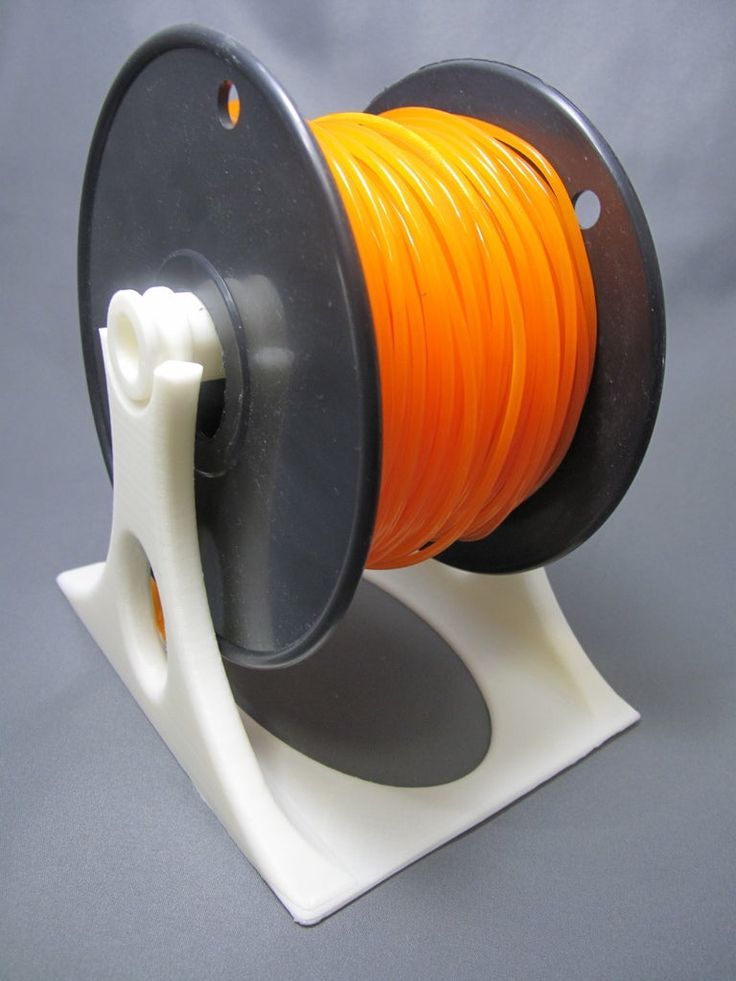 With its ~$80 price tag, this solution probably doesn't make sense if you have a large filament collection.
With its ~$80 price tag, this solution probably doesn't make sense if you have a large filament collection.
The ideal use for the Sunlu S1 would actually be to dry and store filament while printing. The included tube makes it easy to print directly from the dry box. Instead of purchasing one of these for every reel you have, consider using it in conjunction with another storage method when the reels are not in use.
-
Made: Sunlu
-
Experts: ~ $ 50
ESUN EBOX
EBOX Built -in and Unique Function (Source: Amazon)
Esun Ebox - Another Dry - Another Dry - Another Dry - Another Dry - Anim threads. However, there are a few things that make this product stand out.
First, it has a built-in scale so you can see the actual weight of your spool of thread. This feature comes in handy when you are trying to print a significant size with an almost empty spool, as we have all probably tried in the past.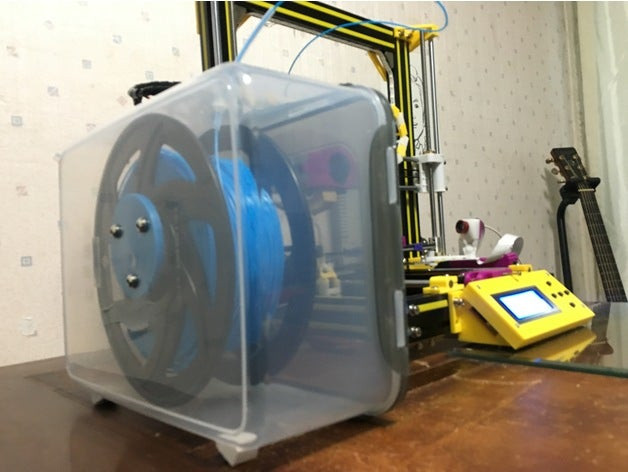 The filament weight can be matched to your slicer before you even start so you don't have any problems.
The filament weight can be matched to your slicer before you even start so you don't have any problems.
Second, unlike the PolyBox (which costs about the same), the eBox has a drying function. Set the temperature and go while your floss goes through a refreshing dehydration session.
The only downside is that the eBox requires household power to operate, making it impractical for long term storage of your filament. Thus, this filament dryer is best used in combination with another storage method.
-
Made: ESUN
-
Costs: ~ $ 70
SUSHOL SOVOL
Thread In this box you can shine and properly store coils with thread (source: SOVOL through YouTube)
Box for drying SOVOL SOVOL SAVE a good alternative for active filament drying. It combines some of the features of other storage boxes with a lower price. The spool is supported by two continuous roller bars, so either a large 150mm wide spool or two 70mm wide spools can be mounted on it.
As for the drying power, the temperature can be set between 40 and 50 degrees, suitable for the most popular materials such as PETG, PLA and ABS. Drying time is controlled by a set timer from 6 to 12 hours.
In addition, it comes with silicone seals and strong latches, which can ensure a dry indoor environment even when active heating is turned off. This makes the Sovol filament dryer a good choice for both drying and storing filament.
-
Made: SOVOL
-
Experts: ~ $ 70
Dry cabinet
Squire cabinet shelves can be adjusted for placement of coils with thread (Source: Amazon)
Supreme Cabinets - New School - New School - New Part filament storage world. They are designed for professional cameras and other photographic equipment that can be damaged by moisture, but they are also sold for other items that are sensitive to moisture. Why not 3D printer filament?
Available in sizes from 30 to 125 litres, dry cabinets are very reminiscent of wine coolers with glass doors and an elegant appearance. The digital screen tells you the temperature and humidity inside the cabinet, which you can set. Lock and keys, LED interior lighting, and adjustable shelves are some other common features of dry cabinets.
The digital screen tells you the temperature and humidity inside the cabinet, which you can set. Lock and keys, LED interior lighting, and adjustable shelves are some other common features of dry cabinets.
A 120-liter dry cabinet can be purchased for about $250 and can hold a dozen rolls of filament if the shelves are properly positioned. No desiccant required, no unsightly containers or nasty packages, and no need to worry about the safety of your 3D printing materials!
-
Made: sling
-
Experts: ~ $ 250
iodotex
It is not visible, but the thermal sigrometer (source: Amazon)
Yodelbox is installed for the CHEITEN which is a low cost version of PolyBox. Holding only one coil at a time, the Yodelbox works best as a dedicated storage container. The Yodelbox is equipped with a battery-powered temperature and humidity sensor and an LCD screen that provides you with real-time data on the conditions inside.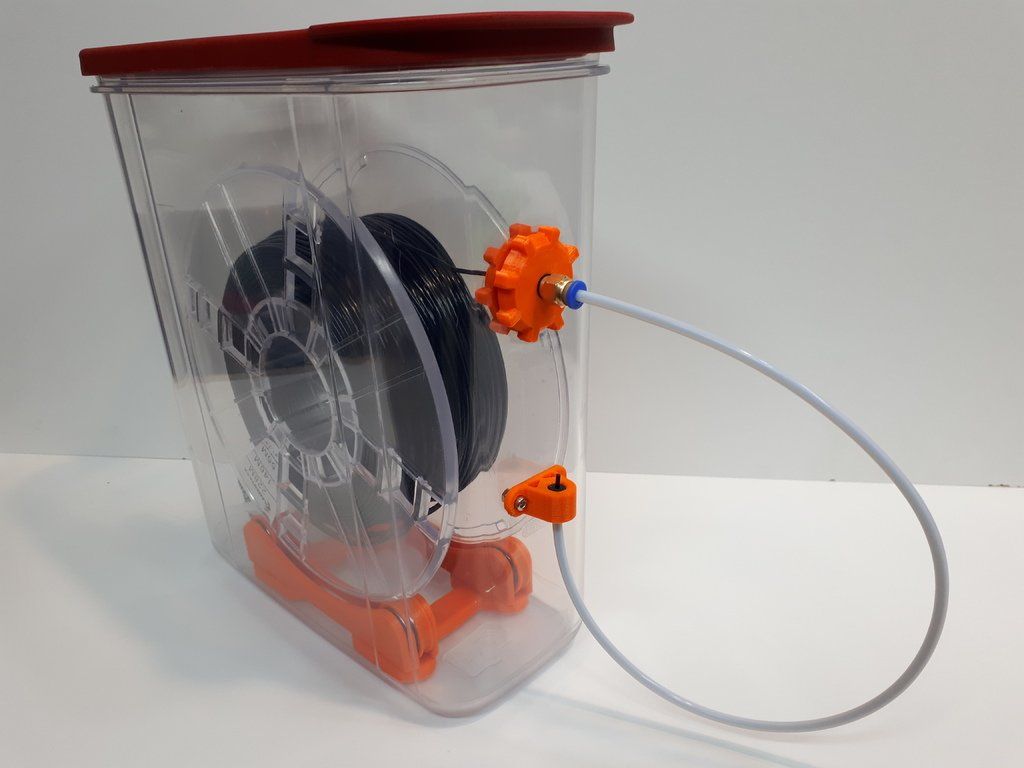
The Yodelbox also has a long tube to connect to the printer and enough space at the bottom of the desiccant container. It would make sense to keep each spool in its own Yodelbox, so when you change the filament you're printing with, just grab another Yodelbox off the shelf and plug it in; thus, the thread will never have to be exposed to the open air!
-
Made: Yodelhaus
-
Costs: ~$45
Bigtreetech filament storage box
Bigtreetech double sized storage comes with carrying handle (Source: Banggood)
Bigtreetech filament storage solution matches Yodelbox. It's basically a simple sealed box with reusable desiccant bags and PTFE tubing connections for a 3D printer. But there are some unique features.
There are three different options to start with. The simplest option, the single spool storage with moisture indicator card (see DIY category), can hold a 20 x 7 cm spool of filament, while the so-called "double consumable" can hold two spools and comes with four tubes. connections.
connections.
Last but not least, the third version is the same single coil vault but with Xiaomi Mijia Bluetooth thermometer and humidity indicator. It is a wireless device that runs on a small CR2032 battery and connects to a dedicated smartphone app that monitors and records data.
As far as pricing is concerned, all versions are officially priced at $29.99 with slight variations depending on shipping costs.
Made: Bigtrite
-
Costs: ~ $ 30
Printdry
Stronged and designed for one roll (source)
Contain for storage of PRINTDRY threads to ensure that another approach to security is ensured. coils. The container itself is designed for storage, not for actively drying the filament or feeding it into the printer, as many other solutions do.
The container is similar to the plastic container you would use to store leftover food. The main differences between PrintDry and a regular plastic cistern are the four strong latches and the valve in the middle of the lid: there's a hand pump that you press on the one-way valve to pump all the air (and moisture) out.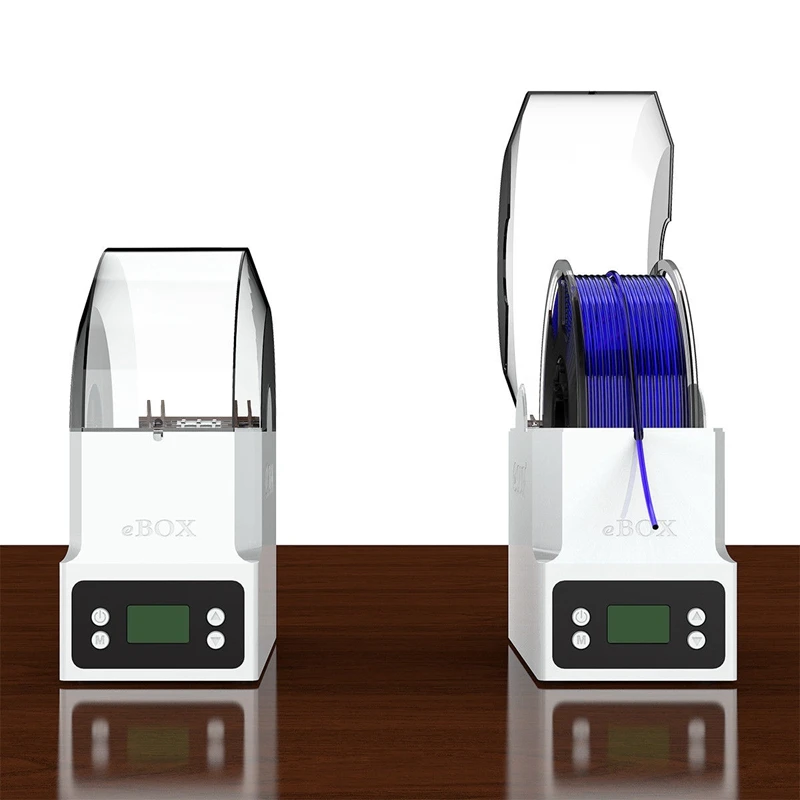
These containers are airtight and can store your floss safely (or they'll be even safer with a desiccant bag) so you don't have to worry about them. The only downside is the price. For a pack of five, you'll end up with about $100. Each container only holds one spool, so you'll spend about the same amount per container as the PLA spool you put inside.
THE MOST STORAGE SOLUTIONS
Now that we know what you can buy, let's see what other options there are! Some are completely DIY, some are repurposed from other household items, but they are all great solutions that are likely to be more affordable than a store-bought product.
Heated Dry Box
Same features as PolyBox at a fraction of the price! (Source: RichRap via Thingiverse)
This solution sits on top of the DIY side of filament storage. With an almost identical design to the PolyBox, eBox, Yodelbox and Sunlu S1, the maker community has endowed this DIY box with optimal filament storage features.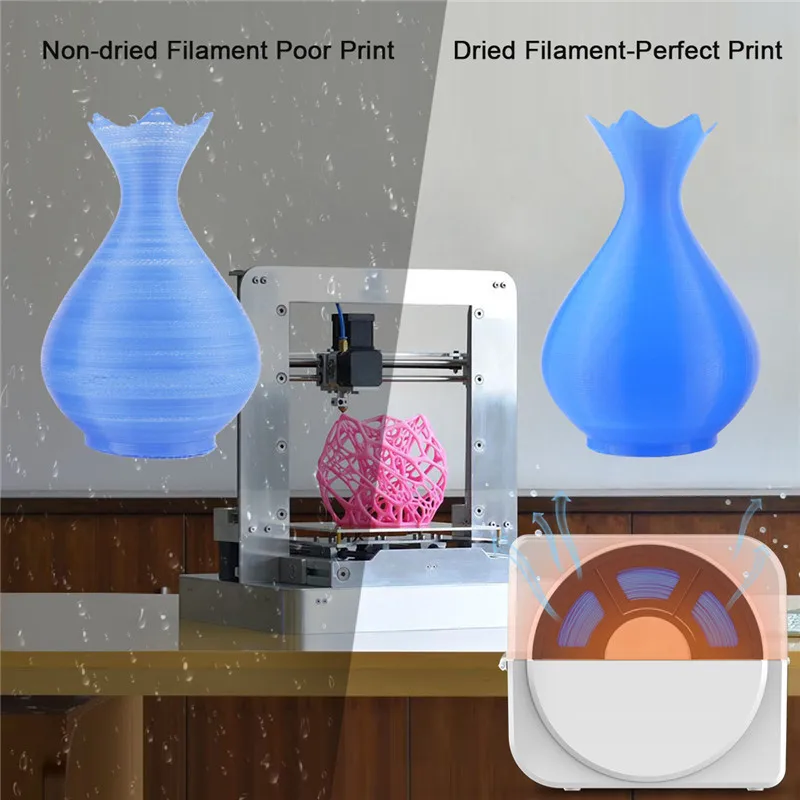 In fact, we have a detailed article on how to make this dry box yourself.
In fact, we have a detailed article on how to make this dry box yourself.
At the heart of this DIY solution is a reptile heating mat placed in an 11 liter plastic jar to heat the filament while desiccant packs remove moisture. An athermal hygrometer, also known as a temperature and humidity sensor, monitors the conditions inside the box. 3D components are available through the Assembly Thingiverse page.
All the components you need should cost between $20 and $30 depending on where you buy them. (You can always buy in bulk and build multiple boxes at a time to make it even more cost-effective.) Some components will need to be 3D printed and will take some time. But in the end, you will have an affordable storage solution with the same features as more expensive models.
Sealed roller box
Designed specifically for pet food, this airtight container can easily serve another purpose. (Source: Amazon)
If you think you can never have too much filament, this is the solution for you. This mobile pet food basket boasts one of the largest capacity of any container on the list. The capacity of the largest hopper allows you to fit up to 17 kg rolls in each container! At around $40, this is one of the most economical solutions.
This mobile pet food basket boasts one of the largest capacity of any container on the list. The capacity of the largest hopper allows you to fit up to 17 kg rolls in each container! At around $40, this is one of the most economical solutions.
This pet food basket is on swivel wheels for convenience and its low height allows it to be hidden under a table or desk. Because pet food is also hygroscopic, pet food containers provide a seal. Please note that several sizes are available; A few smaller containers might also be a good choice, depending on your setup.
A fair amount of desiccant should be placed on the bottom, preferably in granular form, to keep the thread as dry as bone. The only problem with the pet food container is that in order to get to the floss at the bottom of the stack, you must first remove all the rolls from the top.
Plastic bags, desiccant and test strips
These bags are stronger than regular plastic Ziplocs (Source: Amazon)
Reusable bags have always been a popular place to store filament.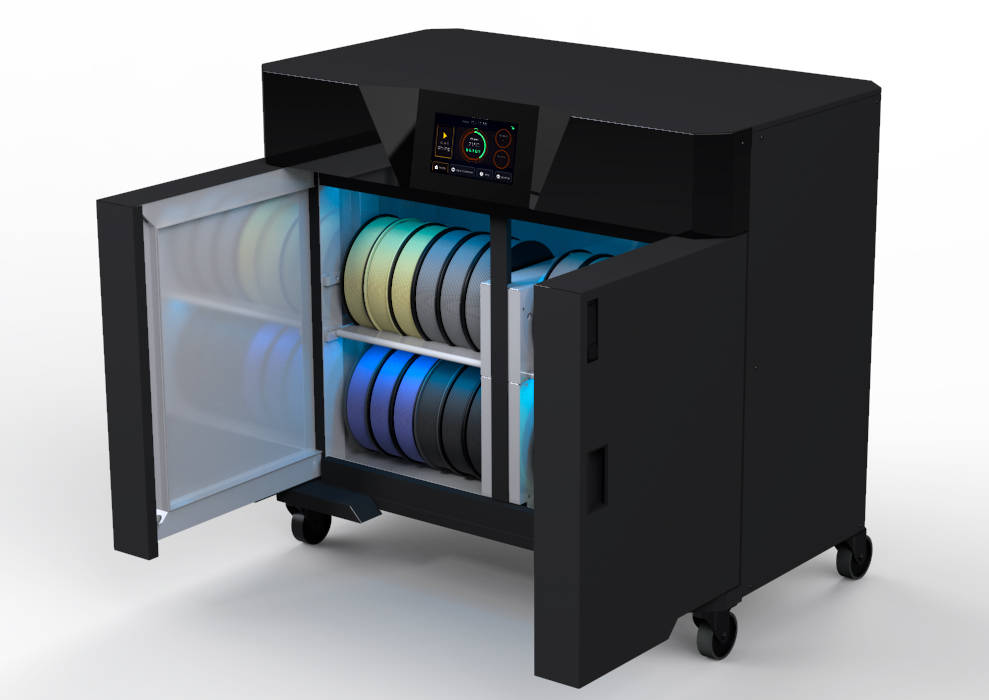 You can go down the route of buying each item individually, but this set of reusable plastic bags, desiccant bags and moisture indicator cards gives you everything you need right away.
You can go down the route of buying each item individually, but this set of reusable plastic bags, desiccant bags and moisture indicator cards gives you everything you need right away.
Although they are not as strong as a box, and you certainly can't feed filament from a bag directly into the printer, the bags do the job just as well as any other sealed container, keeping moisture and dust out. In addition, the indicator strips change color with humidity levels, functioning similarly to the LCD hygrometers found in more expensive dry boxes. These 64-ounce storage pouches are more durable than standard food pouches, and at around $15 for a set of five, you can store many, many rolls of filament with this method.
Vacuum storage bags
These bags are durable, functional and inexpensive (Source: Amazon)
Many of us are familiar with vacuum storage bags. Most popular for storing and transporting clothes, etc. These bags work with either a hand pump (often included) or a household vacuum cleaner (for faster results).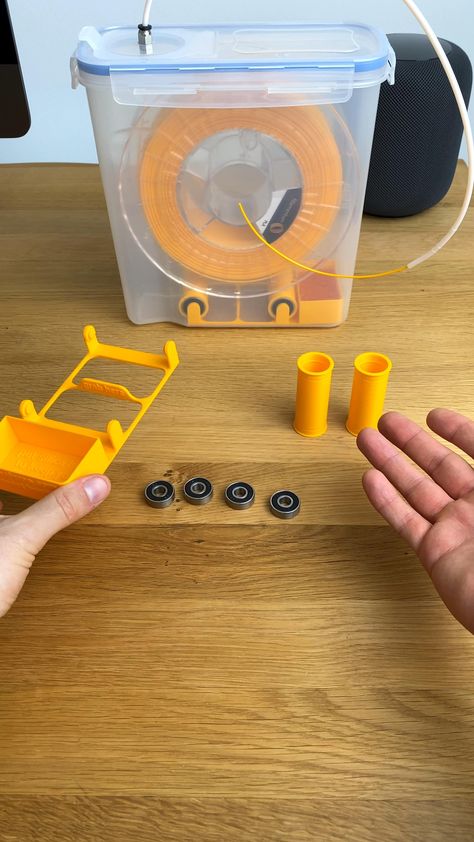 Similar to the PrintDry solution, you suck all the air out of a heavy-duty plastic bag through a one-way valve and the bag compresses whatever is inside.
Similar to the PrintDry solution, you suck all the air out of a heavy-duty plastic bag through a one-way valve and the bag compresses whatever is inside.
We recommend adding some desiccant before pumping all the air out, but this is not necessary. No air means no humidity and no dust; it is so simple!
These bags come in a variety of sizes, the smallest being 16" x 24". You should be able to fit three 1-kg coils in each to make the most of your space. At just a few dollars a piece, this solution won't break the bank either.
Additions
One of the many thread clips available on Thingiverse (Source: Aliendagwood via Thingiverse)
Regardless of the solution you choose, these two additions are 3D printable, small and extremely useful.
Filament clamp
Storing floss with an unprotected end is a big no-no. If your spool of filament doesn't have a hole around the edge to secure the free end, or if the free end doesn't reach the hole, try this solution.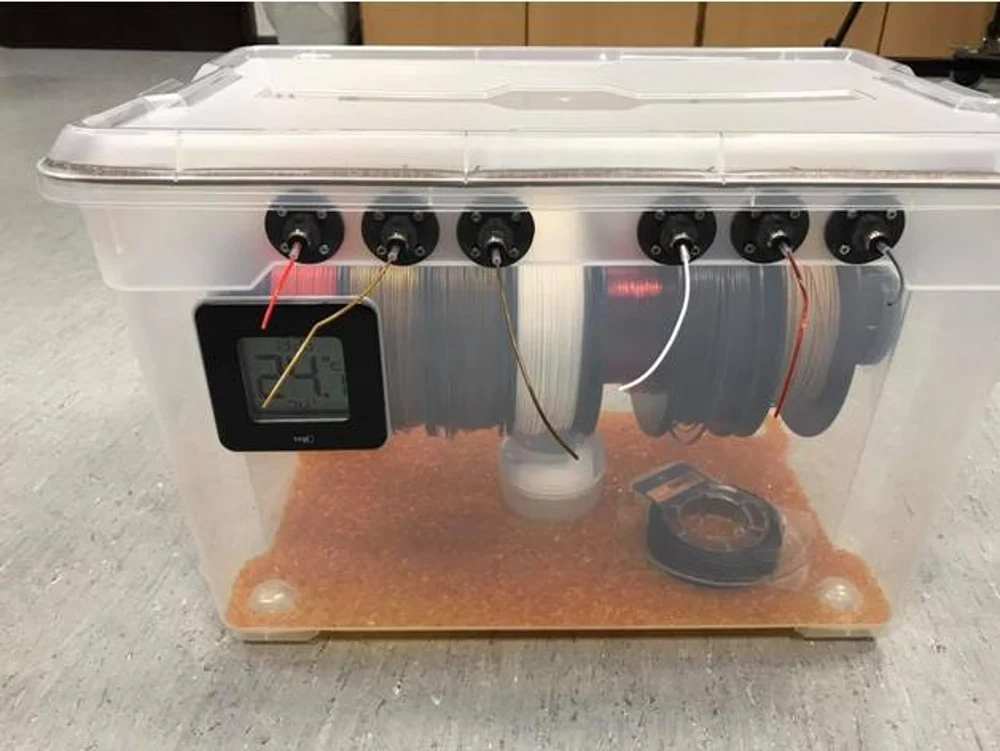 This simple little clip attaches to the outer edge of the spool and can hold the filament securely.
This simple little clip attaches to the outer edge of the spool and can hold the filament securely.
Dust filter
Dust is known to be the enemy of 3D printing. To mitigate this, you can print a small capsule that attaches to your filament and contains a piece of sponge or cloth material, dusting the filament as it passes through it.
Although many variations of this design are available, you can also simply take a piece of folded cloth or paper towel and fasten it to a thread with a clip.
Bonus: desiccants
Most silica gel desiccant packs contain color indicating balls (Source: Amazon)[
Many of the filament storage solutions on this list require the use of desiccants. A desiccant is something so hygroscopic that it preferentially absorbs all the moisture from the indoor environment. Dehumidifiers are most often found in small bags, but they can also be purchased in beads.
Bags or pouches
Bags are the most common form of desiccant.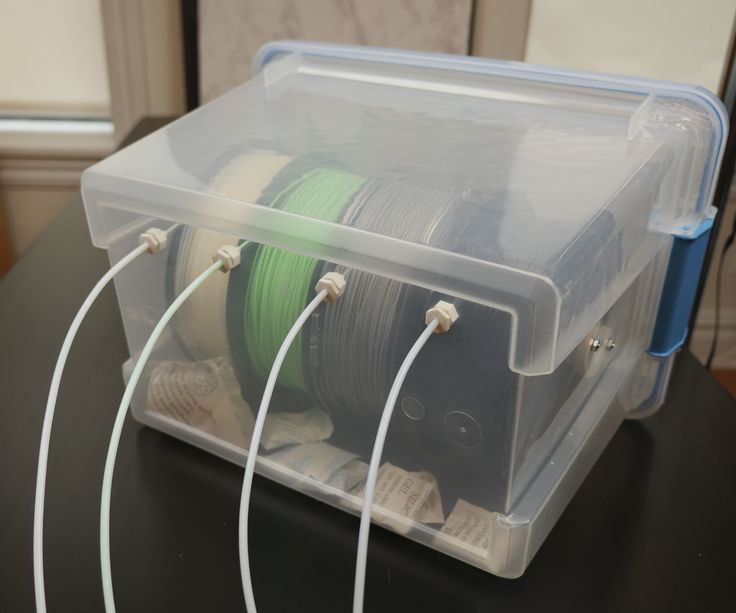 They are convenient, inexpensive and available in various sizes from 0.5 to 500 grams. Bulk purchase is recommended as 50g bags can be purchased in 24-packs for approximately $24 USD each.
They are convenient, inexpensive and available in various sizes from 0.5 to 500 grams. Bulk purchase is recommended as 50g bags can be purchased in 24-packs for approximately $24 USD each.
Beads
Inside the desiccant bags are the desiccant beads themselves. These beads range in size from 2mm to 4mm and can be bought by weight and used as is. If you need more power to dry your thread, beads are a good choice. That's about $35 a gallon, which is made up of 7.5 pounds of beads.
Rechargeable
With the exception of disposable desiccants, the vast majority of balloons and bags can be "recharged". This is achieved by baking the desiccant at a very low temperature in an oven, dehydrator, or even microwave. When the dehumidifier is saturated, simply recharge it by drying out any excess moisture and you're done. Keep in mind that the more desiccant in the container, the less frequently you will need to recharge it.
Color indication
Most dehumidifiers on the market have a color indication function.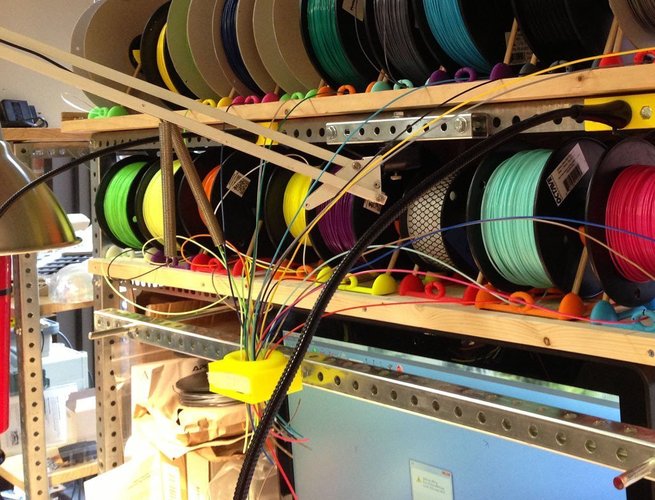 This means that as the desiccant becomes saturated with water, the color will gradually change from, say, blue to orange or orange to green, depending on the desiccant. This feature is available for both bags and beads, although sometimes it can be difficult to see the color change through the fabric of the bag.
This means that as the desiccant becomes saturated with water, the color will gradually change from, say, blue to orange or orange to green, depending on the desiccant. This feature is available for both bags and beads, although sometimes it can be difficult to see the color change through the fabric of the bag.
How Much You Need
While it never hurts to be careful when it comes to dehumidifiers, there is a formula for how much dehumidifier you need for any given volume of air: find the volume of your container in cubic feet and multiply that by 1.2 . This will give you the number of units of desiccant you will need for this container.
The unit of desiccant is about an ounce, but more specifically, it can be defined as the amount needed to absorb either three grams of water at 20% relative humidity, or six grams of water at 40% relative humidity, at a temperature of 25°C. 77 degrees Fahrenheit). However, to simplify, it is much easier to use the formula: 1 unit of desiccant = 1 ounce.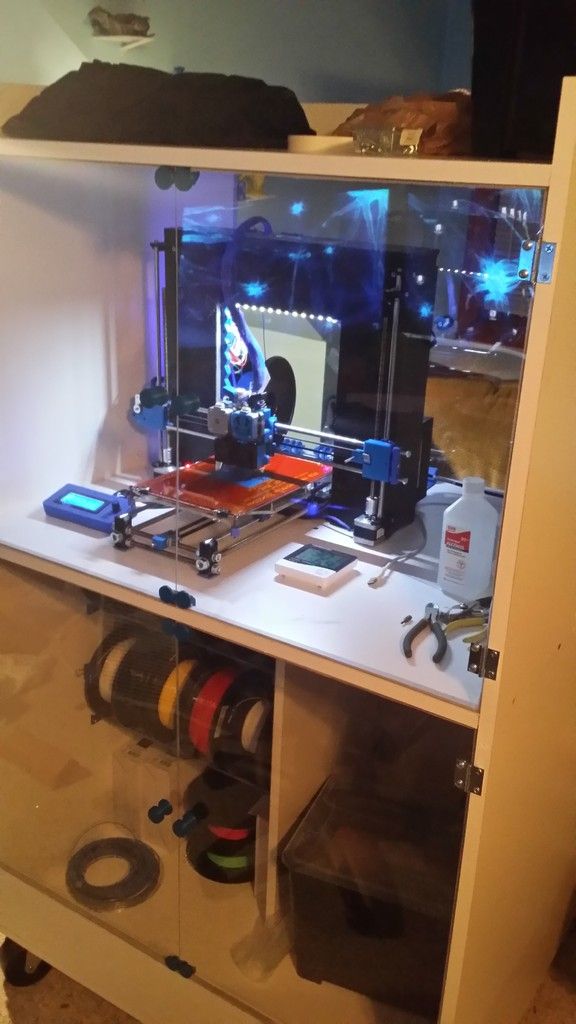
Correct Filament Storage
3D printer filament requires special storage conditions. For the most common PLA, ABS, PETG and TPU filaments, the main requirement for storage is the absence of moisture. Also important is the absence of dust and solid particles during storage of the thread. Let's take a closer look!
What's so dangerous about moisture?
Most materials used in FDM 3D printing can be considered hygroscopic, meaning that they absorb water molecules rather than repel them. This does not mean that the plastic filament will act like a sponge, but if you leave it outdoors, the print quality will deteriorate. Even what may be considered relatively low environmental humidity can damage the filament through a cumulative effect.
Storing the filament in an airtight container is a must to prevent absorption of moisture from the air, but it is even better to use airtight containers or containers with a desiccant (silica gel).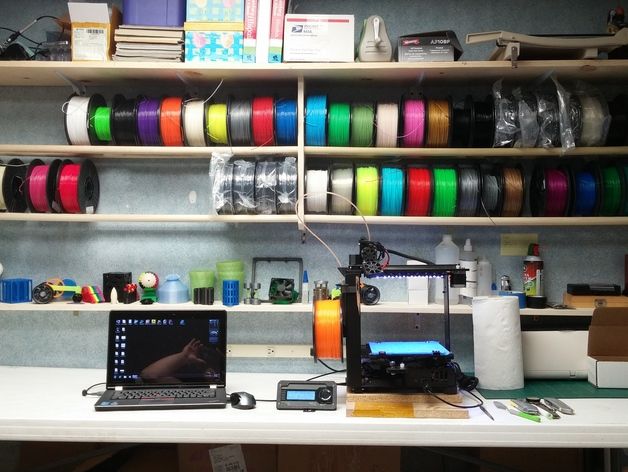 See the end of this article for more information on silica gel.
See the end of this article for more information on silica gel.
How do you know if your filament is wet and needs to be dried? The answer to this question can be found in our other article about drying the filament
Need for storage
Leaving the filament in the open air, solid particles and dust begin to settle on its surface. These small “contaminants” can lead to reduced print quality, and sometimes they even cause the nozzle to clog during printing.
Often, replacing or cleaning the nozzle on some printer models causes problems. Avoid getting dust on the filament. All this can be achieved by simply storing the filament in closed containers or other places protected from airborne particles. Also use a dust filter (see Add-ons section at the end of the article), through which the filament slides during the printing process and traps “dirt” particles before they enter the extruder.
Best filament storage solutions
Below are FDM storage solutions.
Specialized box
This box usually holds two spools at once, which is very convenient when printing with two plastics at once.
Universal specialized container for storage and supply of filament. This solution is not just a plastic box, but also various sensors, a screen for displaying temperature and humidity inside the box.
Boxes are available both for one reel and for two reels of 750 g each, sometimes a 2 kg reel can be placed there. In some models, for convenience, special rollers on bearings are provided that allow the spool to rotate freely when it is used in printing.
These units often have a pair of 100 gram silica gel bags installed rather than heating elements.
Prices for ready-made solutions vary and you can find the perfect option for yourself.
Drying cabinet
The adjustable shelves of this cabinet can be adapted to any size and volume of filament spools.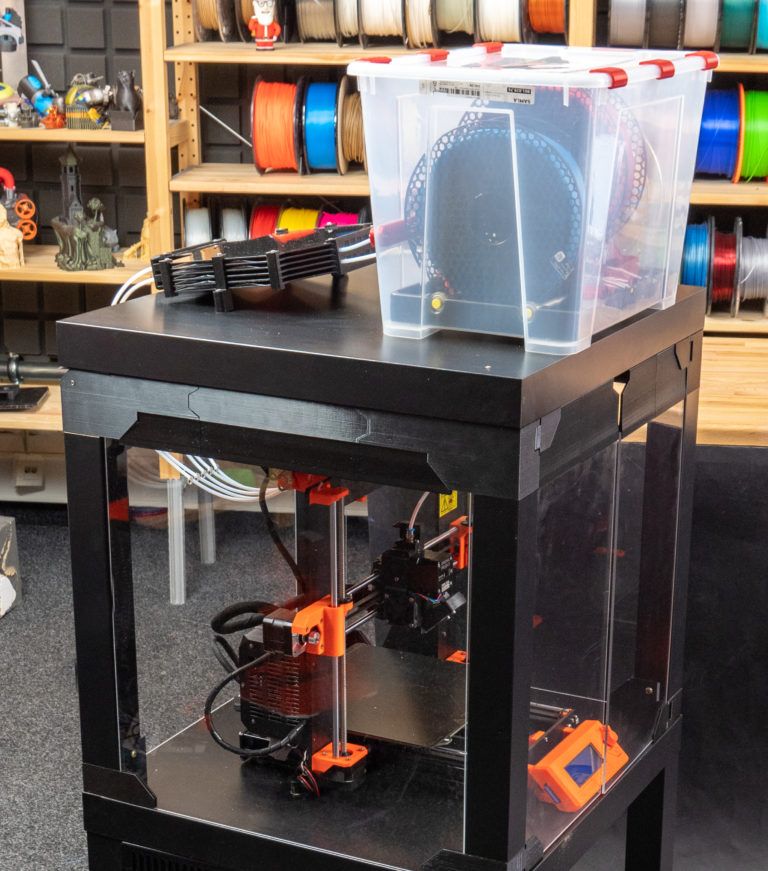
Dry cabinets - the new player in filament storage. Generally they are intended for professional cameras and other photographic equipment that can be damaged by moisture, but they are also sold for other moisture-sensitive items. Why not use it for 3D printer filament?
Available in sizes from 30 to 125 liters, dry cabinets are very reminiscent of wine coolers with their glass doors and elegant appearance, a big plus for those who love aesthetics and beauty. The digital screen tells you the temperature and humidity inside the cabinet, these parameters can be changed by yourself.
Of course, such a cabinet is expensive, but with the right configuration of the shelves it can hold a lot of reels with plastic and maybe even a couple of wine bottles will fit in there.
Storage box lite
This is a cheaper version of the filament storage box than the specialized box. Only one coil can be placed in such a box.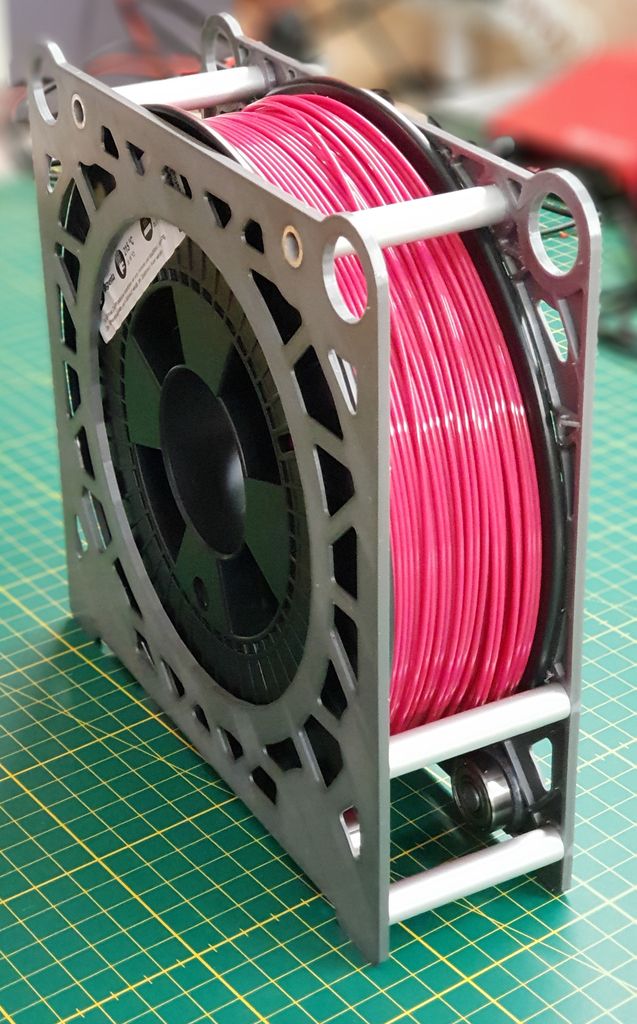 Equipped with a battery-powered temperature and humidity sensor. The LCD screen allows you to get information about the storage conditions inside the box.
Equipped with a battery-powered temperature and humidity sensor. The LCD screen allows you to get information about the storage conditions inside the box.
The box has a long teflon tube for connecting to the printer, a place at the bottom of the silica gel container and a very tight lid. Such a single storage of coils allows you to quickly get the necessary container with the necessary material during printing and put it into printing. This use will prevent moisture and other particles from getting onto your print media.
Vacuum box
This filament storage container takes a distinctly different approach to storing reels. The container itself is designed for long-term storage, and not for actively drying the filament or feeding it into the printer, as other options do.
The box is made of durable plastic, which is able to withstand certain loads when pumping out air. Equipped with 4 durable, plastic latches and a valve in the middle of the lid.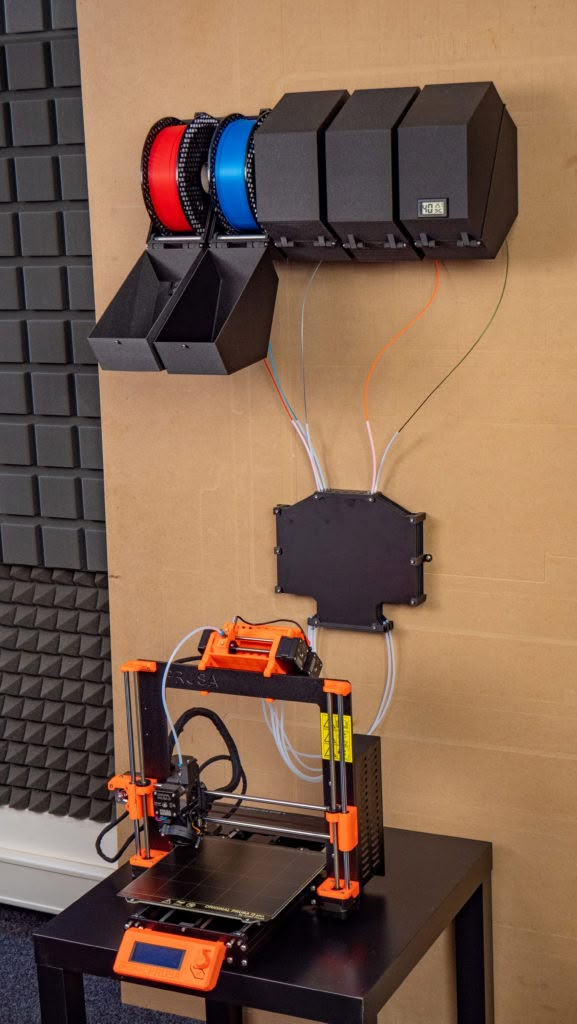 The valve is designed to pump air out of the container using a special pump.
The valve is designed to pump air out of the container using a special pump.
These containers are very airtight and can safely store your roll of plastic for a long time. You can also put a bag of silica gel inside. The only downside is the price.
There are cheaper options, but they are already without such powerful latches.
DIY
Now, let's look at options that you can make yourself. Some are a little more complex and functional, while others are quite light and affordable.
DIY box (Source: RichRap via Thingiverse)
This solution is perfect for storing filament if you want to do it yourself. All ready-made solutions practically do not differ from this option, the only difference is the appearance.
This DIY box uses a reptile heating mat at the base, placed on the bottom of the box, and includes silica gel sachets. A temperature and humidity sensor is installed that monitors indicators inside the box.
3D components are available on the Thingiverse build page. You can use REC
plastic to print them. The remaining components will need to be bought separately and it is better to take a pair at once, it will be cheaper and you will have more space to store the plastic spools.
As a result, you will get a great cheap box with good features.
Airtight Roll Container
Generally made specifically for pet food, but also great for storing lots of spools of plastic. If you think that you have too many spools of plastic and not a single container can cope with such a volume, then you are mistaken! This is not only a huge container, but it is also on 4 swivel wheels. It will be extremely easy and convenient to move it. Tightness at a height, because. it was developed to store food, and as we know, food is also hygroscopic.
A large amount of silica gel can be put on the bottom, which will completely get rid of moisture inside the box.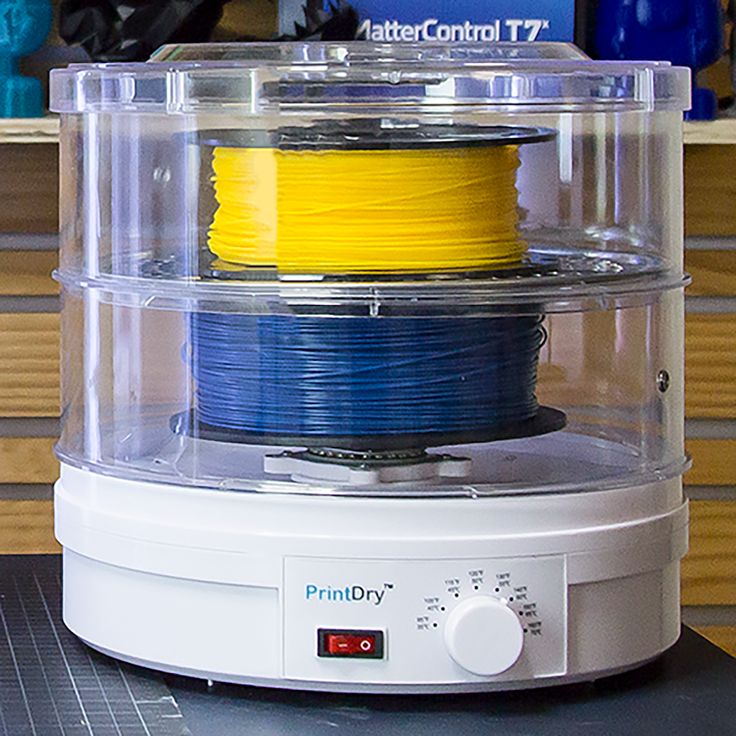 The only disadvantage of such huge boxes is that when you need to get the coil that lies at the bottom, you will have to get all the coils lying above first.
The only disadvantage of such huge boxes is that when you need to get the coil that lies at the bottom, you will have to get all the coils lying above first.
Affordable price for this amount of usable space inside.
Zip Lock Bags
Resealable bags have always been a popular storage item for filament. Such bags are made of more durable and thicker plastic, so that moisture does not penetrate into the inside of the bag. A good zip lock, when properly closed, will ensure tightness.
Even though the pouches are not as strong as a box and you certainly can't print directly from the pouches, they do the job just as well as any other sealed container. Only one coil is placed in such a package. But at a completely low price for such a package, you can buy a lot of them and use them for a long time.
There are also zip bags with an indicator strip that will show the humidity inside the bag
Vacuum storage bags
Many of us are familiar with vacuum storage bags. Most popular for storing and transporting clothes and the like, these bags work with either a hand pump (often included) or a household vacuum cleaner (for faster air extraction). A simple solution with a valve, just put the coil (you can have several) in a bag and pump out the air - that's it.
Most popular for storing and transporting clothes and the like, these bags work with either a hand pump (often included) or a household vacuum cleaner (for faster air extraction). A simple solution with a valve, just put the coil (you can have several) in a bag and pump out the air - that's it.
It is of course recommended to add silica gel before pumping out all the air, but this is not always necessary.
These bags are available in different sizes and opacity (transparent and opaque). In opaque bags, it is best to put plastic that is affected by the sun's rays.
Low price for these bags
OPTIONS
Filament End Clamp / Holder
One of the many Filament Clamps available on Thingiverse (Source: aliendagwood via Thingiverse)
go there will be an overlap. So if your filament spool doesn't have a hole around the edge (REC spools do) to secure the free end, or the free end doesn't quite reach the hole, try printing this accessory. A small clip fits onto the outer rim of the spool and securely holds the end of the filament. Download here
A small clip fits onto the outer rim of the spool and securely holds the end of the filament. Download here
Dust filter
Dust is known to be the enemy of 3D printing. To avoid dust accumulating on the surface of the rod, you can print a small capsule into which a sponge or piece of cloth is inserted and when the rod passes through this capsule, all the dust remains outside the extruder. You can also download it on Thingiverse
Silica gel
In general, silica gel is a dried gel formed from supersaturated solutions of silicic acids. It absorbs moisture very well.
Most often, silica gel is found in portion packs from 5 to 500 grams. The bags themselves contain silica gel balls, the size of the balls is from 2-4 mm.
Sometimes there are options without bags, there are just balls and you pour them into the right place in the right amount.
Color indication.